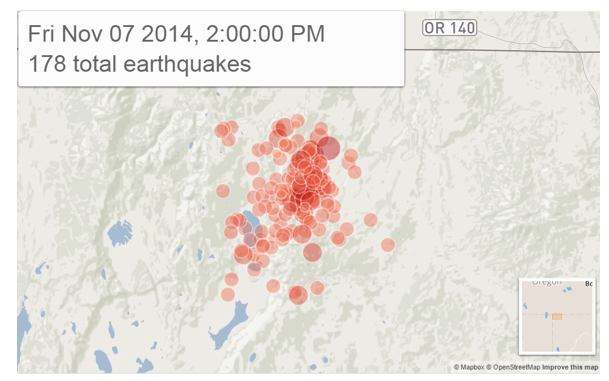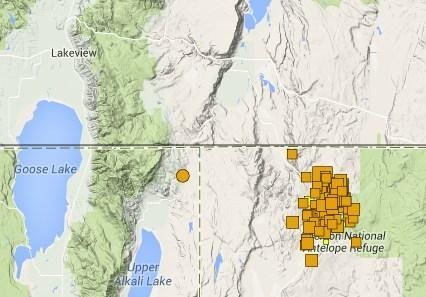
© LA Times
A swarm of hundreds of earthquakes that has been striking a corner of the Nevada desert near the Oregon border for months has intensified in recent days, prompting new warnings from seismologists.
About 750 earthquakes, mostly magnitude 2.0 to 3.0, have struck the area about 50 miles southeast of Lakeview, Ore., since the swarm started in July, said Ian Madin, chief scientist for Oregon's Department of Geology and Mineral Industries.
The temblors have been growing steadily stronger with time.
Six earthquakes of magnitude 4.0 or greater have struck the area since Tuesday and about 40 have struck in the last 24 hours, Madin said.
"This week it has just gone crazy," Madin said.
The swarm is beneath an uninhabited part of the Nevada desert near the Sheldon National Wildlife Refuge, but officials are telling the public, especially the almost 2,300 residents of Lakeview, to develop earthquake plans if they haven't already.
"If you are not ready for an earthquake, now is an awfully good time to get ready for an earthquake," said Alison Ryan, a spokeswoman for the department.
Scientists believe groundwater is slowly percolating along the faults and building up pressure, making movement on the faults much easier, said John Vidale, director of the Pacific Northwest Seismic Network at the University of Washington.
Comment: For more on what's really going on with the increasing earth changes, their cosmic origins and humanity's role in them, read
Earth Changes and the Human-Cosmic Connection by Pierre Lescaudron and Laura Knight-Jadczyk.
"While official science portrays the crazy weather, more frequent sinkholes, increased meteor fireball activity, and intensifying earthquakes as phenomena that are unrelated, research put together by Pierre and Laura strongly suggests that all this (and more!) is intimately connected and may stem from a common cause.
In times past, people understood that the human mind and states of collective human experience influence cosmic and earthly phenomena. How might today's 'wars and rumors of wars', global 'austerity measures', and the mass protest movements breaking out everywhere play into the climate 'changing'?"
You can listen to or read the transcript of the SOTT editor's interview with the authors
here.

Comment: Based on USGS data, earthquake frequency has risen sharply by more than 30% since the 1990s. There is a strong correlation proven between earthquakes and sunspots. An intensification of the magnetic field has implications for Earth's crust, triggering earthquakes. Precursors that indicate alerts of this potential rise also include increases in: low frequency electromagnetic emission, magnetic field anomalies, earthquake lights from ridges and mountain tops, temperature anomalies over wide areas and changes in plasma density of the ionosphere. While we think of rocks as being poor conductors of electricity, there are times when this is the reverse, as when under severe stress from the slowing down of earth rotation, the reduction in gravity that allows for an "opening up" phenomenon that increases the chances for strong earthquakes, and the reshaping of Earth from more ovoid to spherical. The Pacific Rim has proved to be one of the most regions conducive to the rising magnitude levels and frequencies of major earthquakes of late.*
Earth Changes and the Human Cosmic Connection: The Secret History of the World - Book 3